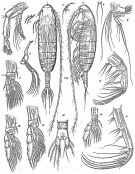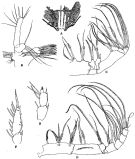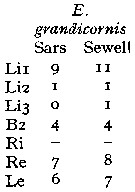|
|
 |
Fiche d'espèce de Copépode |
|
|
Calanoida ( Ordre ) |
|
|
|
Arietelloidea ( Superfamille ) |
|
|
|
Augaptilidae ( Famille ) |
|
|
|
Euaugaptilus ( Genre ) |
|
|
| |
Euaugaptilus grandicornis Sars, 1920 (F) | |
| | | | | | | Ref.: | | | Sars, 1920 c (p.14); 1925 (p.286, figs.F); Sewell, 1947 (p.207, figs.F); Matthews, 1972 (p.32) |  Issued from : G.O. Sars in Résult. Camp. Scient. Prince Albert I, 69, pls.1-127 (1924). [Pl.XCIV, figs.1-15]. Female: 1, habitus (dorsal); 2, idem (lateral left side); 3, forehead (lateral); 4, rostrum; 5, A2; 6, Md; 7, Md (masticatory edge, enlarged); 8, Mx1; 9, Mx2; 10, Mxp; 11, P1; 12, P2; 13, P3; 14, P5; 15, posterior part of urosome (dorsal).
|
 issued from : R.B.S. Sewell in The John Murray Expedition, 1933-34, Scientific Reports, VIII (1), 1947. [p.208, Fig.54]. Female (from N Arabian Sea): A, the glands of the anterior lip of the mouth; B, Mx1; C, Mx2; D, Mxp; E, exopod of P3 (abnormal); F, exopod of P4 (abnormal). Nota: Labrum strongly chitinized, and on either side of the middle line is produced backwards in a rounded papilla, on the tip of which a series of well-developed glands open; on either side of this papilla the margin slopes forwards and outwards, and about half way along its length is produced in another rounded eminence, on the inner face of which another glands opens; the surface of the labrum is provided with three rows of fine hairs, an anterior crossing the middle line and two postero-lateral. A1 25-segmented, overreaches the tip of the caudal rami by about the last 7 segments. In A2 the exopod consists of 8 segments (the joint between the 7th and 8th not very well marked). Mx1 differs slightly from Sars; inner lobe 1 with 11 setae (the larger ones being fringed with spinules), inner lobe 2 with 1 stout and long seta, inner lobe 3 is present, though of a reduced size, and bears 1 small seta; the portion of the appendage that corresponds to the 2nd basal segment bears 3 setae inwards towards the mouth, and a fourth one that projects distally (possibly this represents the remains of the endopod); the exopod bears 8 setae, of which the four outer are of moderate size, the 5 th is very long and stout, the 6th is large, and the 7th and 8th are small.
|
 issued from : J.B.L. Matthews in Bull. Br. Mus. (Nat. Hist.) Zool., 1972, 24 (1). [p.25, Table 2]. Differences in setation of Mx1, according to previous descriptions.
| | | | | Ref. compl.: | | | Sewell, 1948 (p.331, 504, 522, 528, 533); Grice & Hulsemann, 1967 (p.18); 1968 (tab.2); Björnberg, 1973 (p.348, 385); Guangshan & Honglin, 1984 (p.118, tab., Rem.: p.165); Madhupratap & Haridas, 1990 (p.305, fig.3: vertical distribution night/day; fig.7: cluster); Matsuura & al., 2010 (p.2098, Table 3, fig.8) | | | | NZ: | 5 | | |
|
Carte de distribution de Euaugaptilus grandicornis par zones géographiques
|
| | | | | |  Issued from : M. Madhupratap & P. Haridas in J. Plankton Res., 12 (2). [p.310, Fig.3]. Issued from : M. Madhupratap & P. Haridas in J. Plankton Res., 12 (2). [p.310, Fig.3].
Vertical distribution of calanoid copepod (mean +1 SE), abundance No/100 m3. 3- Euaugaptilus grandicornis.
Night: shaded, day: unshaded.
Samples collected from 6 stations located off Cochin (India), SE Arabian Sea, November 1983, with a Multiple Closing Plankton Net (mesh aperture 300 µm), in vertical hauls at 4 depth intervalls (0-200, 200-400, 400-600, 600-1000 m). |
| | | | Loc: | | | N Atlant. (W Azores), Arabian Sea, W Indian, Indonesia (Celebes Sea), Pacif. (W equatorial), off Juan Fernandez Is., S Peru. | | | | N: | 9 | | | | Lg.: | | | (1) F: 7,4; (11) F: 6,17; {F: 6,17-7,40} | | | | Rem.: | bathypélagique.
Guangshan & Honglin (1984) signalent cette espèce dans le Pacifique W tropical.
First occurrence in Indonesian waters by Matsuura & al. (2010).
Voir aussi les remarques en anglais | | | Dernière mise à jour : 15/06/2020 | |
|
|
 Toute utilisation de ce site pour une publication sera mentionnée avec la référence suivante : Toute utilisation de ce site pour une publication sera mentionnée avec la référence suivante :
Razouls C., Desreumaux N., Kouwenberg J. et de Bovée F., 2005-2026. - Biodiversité des Copépodes planctoniques marins (morphologie, répartition géographique et données biologiques). Sorbonne Université, CNRS. Disponible sur http://copepodes.obs-banyuls.fr [Accédé le 07 janvier 2026] © copyright 2005-2026 Sorbonne Université, CNRS
|
|
 |
 |







